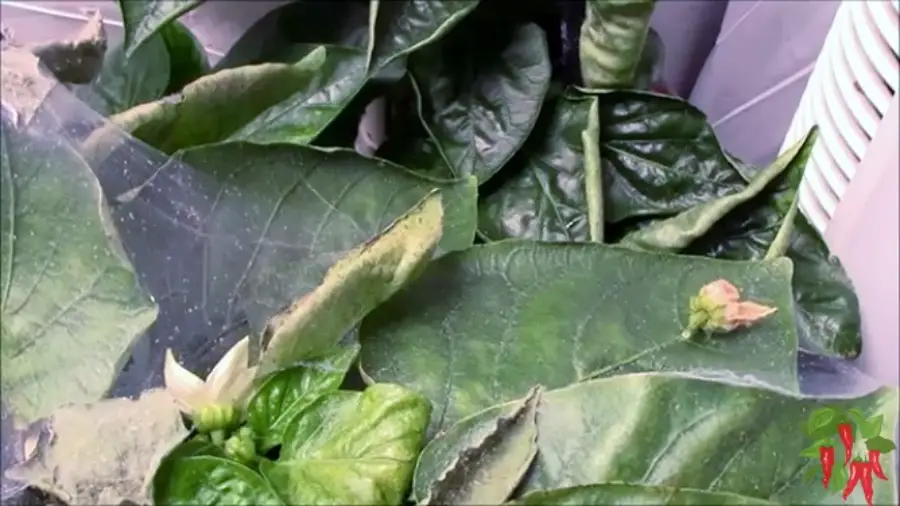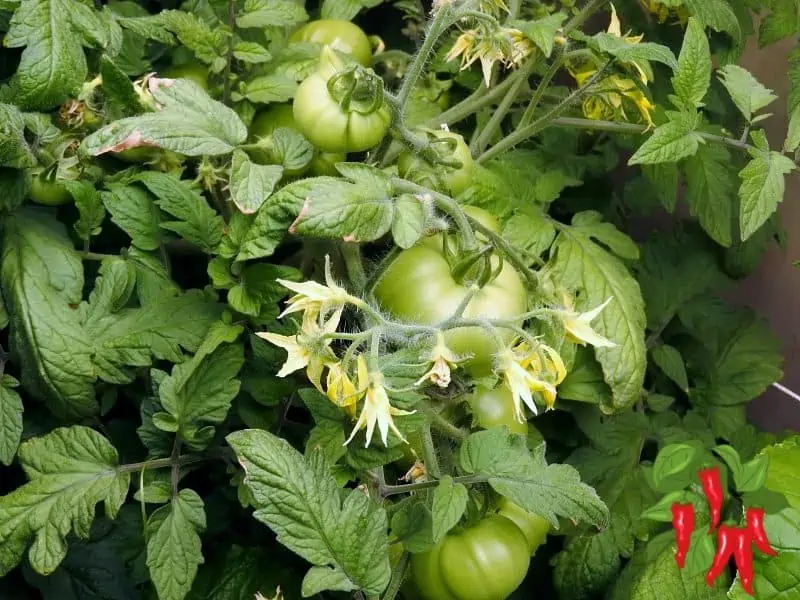This post may contain affiliate links. If you buy something from one of our links we may earn a commission. Thanks

Spider Mites on Peppers!
Gardening is not without its surprises and BLEEP Happens! This morning I accidentally broke off a nice branch from my pepper plant loaded with peppers.
Then I discovered spider mites on my peppers. They had webbing and tents right on top.
BLEEP HAPPENS! Spider mites on peppers! Video
I saw signs of leaf curling that I thought were caused by low humidity but I was wrong.
Usually, you see signs of stippling on the leaf tops caused by mites sucking the sap from the underside of the leaf.
Last week there were no signs of that, just the curling of leaf edges. So I was really suprised to see their tents on top of one of my pepper plants.
It’s a safe bet they are on my other plants including the tomato plant. Watch my video where I show you them and explain how to deal with the little buggers.
What Are Spider Mites?
Spider mites are members of the Tetranychidae family, which includes about 1,200 species. They are part of the subclass Acari. Spider mites generally live on the undersides of leaves of plants, where they may spin protective silk webs, and can cause damage by puncturing the plant cells to feed.
Scientific name: Tetranychidae
Size: 1/25-1/20 inch usda.gov
Class: Arachnida
Family: Tetranychidae; Donnadieu, 1875
Kingdom: Animalia
Order: Trombidiformes
Wikipedia
How To Deal With Spider Mites
Howdy everyone! Today we’re diving into the pesky world of spider mites and how you can send these little buggers packing. Let’s tackle this, one step at a time.
Dealing With Spider Mites Key Takeaways:
- Use Insecticidal Soap: Apply directly to infested areas, focusing on the undersides of leaves where mites congregate.
- Apply Neem Oil: Effective as both a treatment and a preventative measure. Use weekly to prevent infestations or when mites are first spotted.
- Identify Mite Habitats: Spider mites typically live on the undersides of plant leaves, where they can feed and stay hidden.
- Spot Early Signs: Watch for leaf curling and fine webbing on your plants, which are early indicators of spider mite presence.
- Prevent Infestations: Check new plants and garden tools to prevent inadvertently introducing mites to your garden or indoor plants.
- Regular Checks: Use a magnifying glass to inspect plants closely for mites and their eggs, focusing on leaf undersides.
- Understand the Life Cycle: Spider mites can hatch and mature rapidly, with new generations developing in as little as a week.
- Maintain Plant Health: Keep plants well-watered and dust-free to deter spider mite infestations.
- These tips should help you manage spider mite issues effectively and keep your garden thriving.
What Kills Spider Mites?
When it comes to evicting these unwelcome guests, you’ve got a couple of trusty tools in your shed:
- Insecticidal Soap: This is your go-to for a quick fix. It’s safe, effective, and doesn’t mess around when it comes to wiping out mites. Just spray it directly onto the infested areas, making sure to hit the undersides of the leaves where these critters love to hang out.
- Neem Oil: A bit like the Swiss Army knife of garden treatments, neem oil not only takes care of spider mites but also helps prevent future infestations. Apply it every week as a preventative measure, or use it when you first spot trouble.
Leaf Stripping – A Radical Approach That Works
When using insecticidal soap or neem oil it is important to cover the entire plant. They are not systemic so they must contact the mites and their eggs.
Leaf stripping can make spraying much easier. I have used this technique as a cannabis grower and it works for vegetables too.
However, you should only do this on healthy plants and don’t remove all the leaves or you may stunt your plants. Remove enough leaves so you can spray all stems and leaf undersides fully. Use a fogger if you have access to one.
Why It Works
When you remove leaves you remove spider mites and eggs reducing the infestation and you make it easier to kill the rest.
Habitat: What Do Spider Mites Live On?
These tiny arachnids aren’t picky; they love settling on just about any plant they can get their little legs on. However, they are fond of the undersides of leaves where they can stay hidden and munch away in peace.
Early Signs of Spider Mites
Keep your eyes peeled for the first signs of attack:
- Leaf Curling: It might look like your plant is just a bit thirsty, but it’s often the first clue.
- Fine Webbing: If it looks like your plants are getting ready for Halloween early with those tiny webs, it’s time to act.
I totally misdiagnosed the leaf curling as the results of low humidity.
How Do You Get Spider Mites?
Believe it or not, these guys can hitch a ride on just about anything. From new plants you’ve brought home to your garden tools if they’ve been near infested plants. Always check new plants before introducing them to your garden or home.
They are very common outdoors and you can bring them in on your clothes or even your pets can bring them in.
They love dry and warm conditions so once they get inside they can quickly get out of hand. So deal with them.
How to Check for Spider Mites?
Spider mites are tiny so grab your magnifying glass and get up close and personal with your plants.
Look for any signs of webbing, stippling, or the tiny mites themselves, which can range from white to dark red.
Spider Mite Eggs
These are super tiny but look for clear to white spherical eggs, often clustered under the leaves. If you spot these, it means a new generation is about to start, so speed is of the essence!
Vinegar to Kill Spider Mites
For a DIY approach, mix equal parts of water and white vinegar and spray it on the affected areas. It’s a harsher treatment, so test it on a small area first to ensure it doesn’t harm the plant.
Some online sources recommend using vinegar to kill mites. I have not personally tried this and I am not convinced it is effective.
Spider Mite Life Cycle
Understanding their cycle can help you time your treatments better. Spider mites can hatch in as little as three days and reach adulthood in about five days. This means you could have multiple generations wreaking havoc in under a week!
That is why it will take at least 2 sprays to kill them. There are commercial miticides but they are expensive and not for beginners or organic gardeners.
Also, spider mites are not insects and many insecticides will not kill them.
Spider Mites on Plants
They’re not fussy about where they live, but they do love dry, dusty conditions. Keep your plants well-watered and dust-free to make them less inviting homes for spider mites.
Remember, the key to control is persistence. Keep at it, and you’ll be able to keep these pests at bay and your peppers happy. Stay green, my friends!
FAQ: Battling Spider Mites on Your Plants
Q. What kills spider mites effectively?
A. Spider mites can be controlled using insecticidal soap and neem oil. Both options suffocate the mites upon contact. Additionally, a home remedy like a soap spray made from a mild liquid soap mixed with water can be effective. Apply these treatments directly to the affected areas, especially under the leaves where mites congregate.
Q. What do spider mites live on?
A. Spider mites thrive on a variety of plants, particularly on the undersides of leaves where they can stay hidden while they feed on the plant’s sap. This makes almost any garden plant vulnerable, especially under dry and dusty conditions.
Q. What are the early signs of spider mites?
A. Early signs include speckled leaves, leaf curling, and the presence of fine, silky webbing on the plant. The leaves may start to look dusty due to the tiny white or yellow spots caused by mites sucking on the plant’s fluids.
Q. How can you check for spider mites?
A. To check for spider mites, inspect the underside of leaves with a magnifying glass. A common method is to shake the plant over a piece of white paper; spider mites will fall off and be visible as tiny, moving dots on the paper.
Q. What about spider mite eggs? How can they be dealt with?
A. Spider mite eggs are best dealt with by repeated applications of insecticidal soap or neem oil, as these substances need to contact the eggs to be effective. Eggs often require multiple treatments because they can be resistant to initial applications (OSU Extension Service).
Q. Can vinegar be used to treat spider mites?
A. Yes, a diluted vinegar solution (equal parts water and vinegar) can help control spider mites. However, it’s important to test this on a small part of the plant first, as vinegar can be harsh on plants.
Q. What’s the life cycle of spider mites?
A. Spider mites can hatch from eggs in as little as three days and reach adulthood in about five days under favorable conditions. Understanding their rapid reproduction rate is key to timely and effective treatment.
Q. Which plants are most commonly affected by spider mites?
A. Spider mites are not very selective and can infest a wide range of houseplants, garden plants, and crops. They particularly thrive in warm, dry conditions, which make indoor environments or greenhouse-grown plants common targets.
Wrapping Up: Winning the War Against Spider Mites
Well, folks, there you have it—your battle plan against those pesky spider mites.
How To Get Rid of Spider Mites:
- To eliminate spider mites, use insecticidal soap or neem oil, applying thoroughly to the undersides of leaves where mites reside.
- Increase humidity around plants as mites thrive in dry conditions.
- Regularly inspect plants and isolate any with signs of infestation to prevent spread
Remember, keeping these critters at bay is all about vigilance and prompt action. Let’s recap some key strategies to ensure your garden stays mite-free:
- Consistent Checks: Regular monitoring is your best defense. Catching mites early can prevent a full-blown infestation (OSU Extension Service).
- Effective Remedies: Whether you opt for natural solutions like neem oil and insecticidal soap or home remedies such as diluted vinegar, ensure you apply these treatments thoroughly. Cover all parts of the plant, especially the undersides of leaves where mites like to hide.
- Environmental Controls: Altering your plant’s environment can discourage mite populations. Increasing humidity and ensuring your plants are well-watered can make your garden less inviting to mites.
- Preventive Measures: Always inspect new plants before introducing them to your garden or home. Keep your gardening tools clean and avoid transferring soil or debris between plants (Bob Vila).
With these tips in mind, you’re well-equipped to keep your garden thriving and mite-free.
Don’t let spider mites put a damper on your gardening passion. Keep an eye out, treat problems early, and enjoy the fruits (and vegetables) of your labor. Remember, every gardener faces challenges, but it’s how you respond that makes all the difference. Keep it green, and happy gardening!
Learn more about Indoor Apartment Gardening: 15 Point Comprehensive Guide
Visit my Amazon Influencer Page for videos and gardening products Grow Your Own Garden






